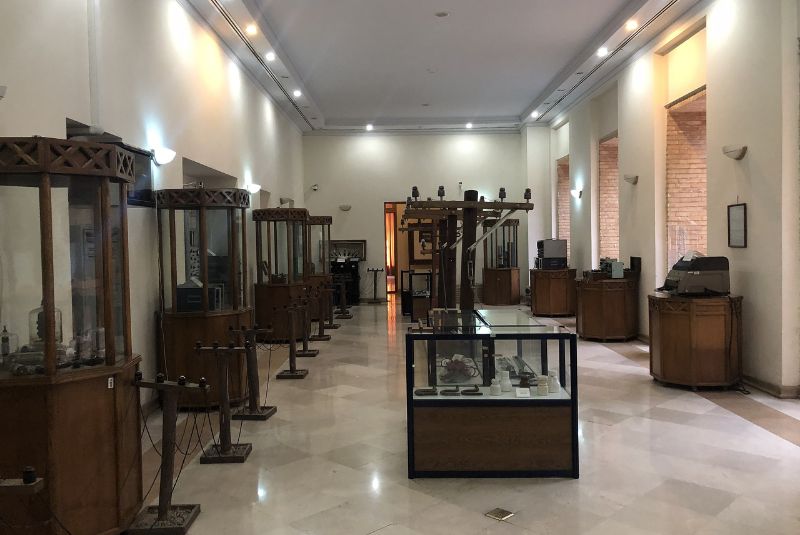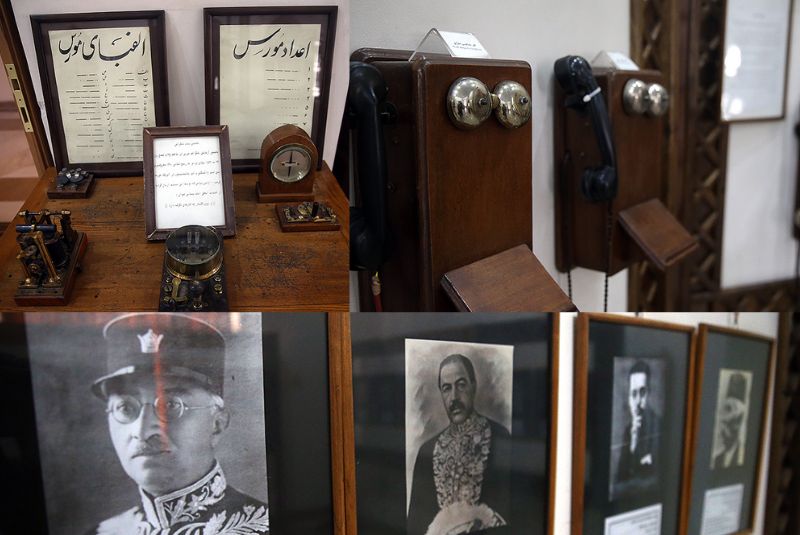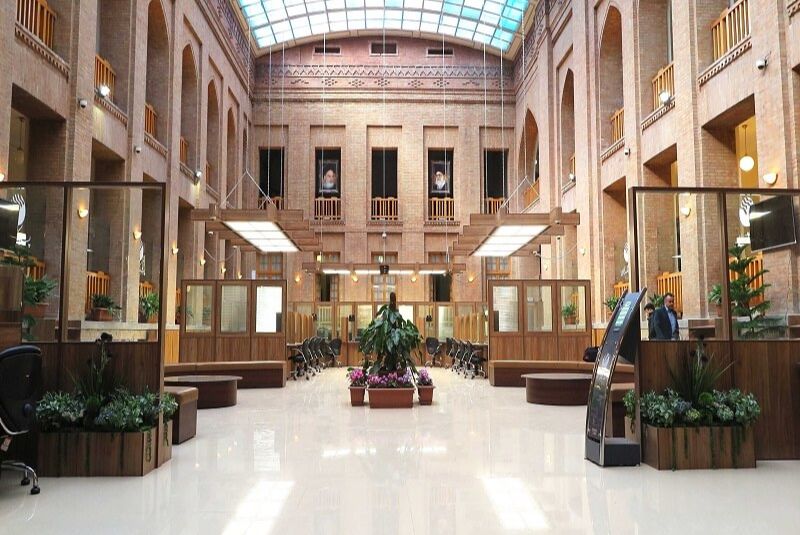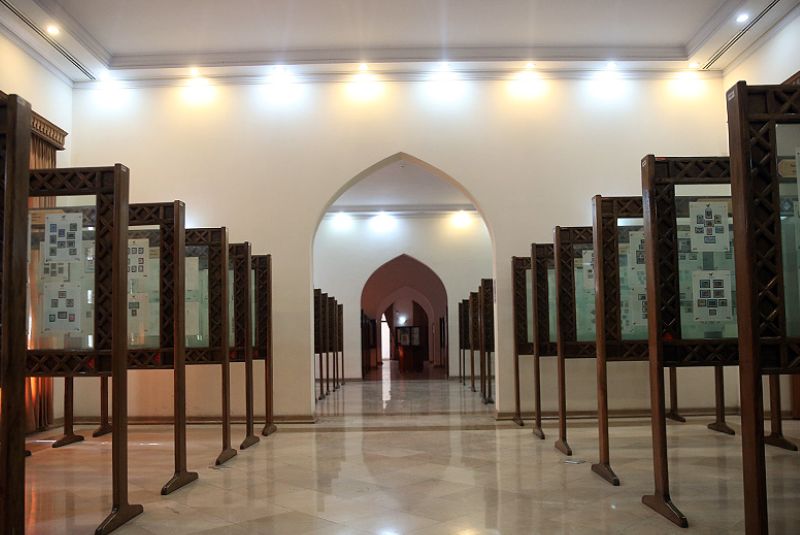Tehran Post & Communications Museum
In the heart of Tehran lies a captivating window into the past – the Tehran Post & Communications Museum.
In an era dominated by technology, this museum offers a unique perspective on the evolution of communication tools. Popular among locals and visitors alike, it stands as a distinctive model in Tehran's museum scene, chronicling the history of communication with simplicity and charm. Join us to dive deeper in Tehran's communication history at the post and communication museum of Tehran.
The Museum's Opening Hours and Ticket Price

Visiting Hours:
- Saturday to Wednesday: 9:00 AM to 4:00 PM
- Thursdays: 9:00 AM to 1:00 PM
- Friday: Closed
Ticket Prices:
- Adults: 50,000 Rials (approximately $1.20 USD)
- Students: 25,000 Rials (approximately $0.60 USD)
- Children under 7: Free
Additional Information:
- Guided tours are available in English and Farsi for an additional fee (price may vary depending on group size).
- Photography is allowed inside the museum, but flash photography is prohibited.
- The museum is accessible for people with disabilities.
Note: It's always best to double-check the latest visiting hours and ticket prices on the museum's official website or by calling them before your visit. This ensures you have the most up-to-date information and a smooth visit.
| Related: Best Museums in Tehran - Definitive Guide
History of Post & Communications Museum

The roots of the Tehran Post & Communications Museum trace back to its establishment in 1932, a pivotal moment when Iran, inspired by European museum design, inaugurated the Post and Telegraph Museum. Initially located in the southern part of Toupkhaneh Square, facing the Municipal Palace, the museum was housed within the Ministry of Post and Telegraph or Telegraph House.
However, the journey of the museum faced a significant disruption in 1970 when the original building, constructed in 1932, was destroyed. In its place, a new edifice emerged in 1952, designed with an internal architectural vision. The architects behind this 15,000 square meter structure were SurIsrafil and Nizam-uddin Hekmat, both notable figures in the realm of post and telegraph ministries.
For nearly four decades, from 1952 to 1971, the museum stood as a testament to the evolution of communication. However, it then encountered a period of dormancy lasting two decades. It wasn't until 1990 that a resurgence occurred. In 1991, the museum found a new home in the reconstructed western section of the former post office, breathing life back into its exhibits.
In 1995, the museum underwent a significant transformation as the Organization of Administrative and Employment Affairs of the country approved the change of its name to Tehran Post and Telegraph Museum. Subsequent years witnessed further evolution – in 2000, it became the Post and Telecommunication Museum, and ultimately in 2014, it was rebranded as the Communications Museum.
Today, the Tehran Communications Museum stands under the ownership of the Ministry of Communications and Information Technology of the country, preserving and showcasing the rich history of communication in Iran.
| Suggestion: Tehran's Most Famous Palaces
Tehran Post & Communications Museum Architecture

The Tehran Post & Communications Museum, formerly known as Tehran's post and telegraph museum, is strategically situated in Mashq or Marsh Square, surrounded by structures dating back to the Qajar era to the first Pahlavi. Notable among these is the sole surviving building from the Naseri period, once belonging to the Ministry of War.
The architectural composition of the museum seamlessly integrates with its historical surroundings, utilizing materials typical of the region. The foundation is constructed from sturdy stone, while the body incorporates the use of brick. Wooden elements, including doors, windows, and the gable roof, add warmth and character to the structure. Notably, the facade columns feature capitals shaped like two cow heads, reminiscent of Achaemenid construction, and archways with Shah Abbasid arches, symbolizing Safavid-era architecture. Entrances to the museum are positioned to the north, south, and east, providing easy access for visitors.
The overall design of the building mirrors the layout of caravanserais, complete with four porches. The inclusion of a king's seat on the first floor, facing a public relations room with a four-and-a-half-meter-wide arch, and a conference room on the second floor with a five-meter-wide arch, enhances the architectural significance. These spaces, distinguished by wider windows, contribute to the building's unique character.
Historical records credit the design to the Georgian architect Nikolai Lvovich Markov, with completion overseen by the Mazloumian. The architectural blueprint follows the principles of Iranian-European fusion, showcasing an eclectic style characteristic of administrative and government buildings from the first Pahlavi era.
The museum's structure is divided into east and west sections along a central axis. The 11th area serves as the entrance point, with identical eastern and western segments. Noteworthy additions, including the Tehran State Post Department, Postal Deposit Customs, and two other departments, are planned for incorporation into the Tehran Post and Telecommunication Museum, setting the stage for it to become the world's largest communication museum.
| Related: Traditional Persian Architecture
Sections of the Tehran Communications Museum

The Museum of Communication has two floors and a basement, and there are eight pavilions on these two floors, each of which deals with a specific topic.
Hall of Ceremonies and Ministers (First Floor)
As you step into the Tehran Communication Museum, the first stop on the first floor is the Hall of Ceremonies and Ministers. This photo display room commemorates 72 of Iran's past ministers, offering a historical journey through the evolution of the communication sector. Among these figures is Ali Qoli Khan Mokhbar-al-Dawlah, the inaugural minister of telegraph in Iran.
Domestic Stamps Booth (First Floor)
Adjacent to the ministers' hall is the Domestic Stamps Booth, housing a collection of stamps ranging from the Qajar era to modern times. Marvel at the Edison cliché and Ahmad Shah stamp cliché, alongside the replica of the Qajar postman and the post alley symbol, as you explore this unique display.
Postal Items Booth (First Floor)
The third booth on the first floor unveils the Postal Items Booth, showcasing an array of artifacts from the Pahlavi era. From diverse mailboxes to stamps from post offices worldwide, manual and electric stamp canceling devices, and even the uniforms worn by post office employees in Iran and other countries, this section provides a comprehensive look into postal history.
Silk Road Pavilion (Central Hall)
In the central hall, discover the Silk Road Pavilion, an immersive experience into the tools and devices that facilitated communication along the ancient Silk Road. From carts and tricycles to airplanes, witness the evolution of parcel transportation. The pavilion also features postmen from the Qajar period, communication maps, and tools and gifts from different countries.
Hall of International Stamps (Second Floor)
Ascend to the second floor to encounter the Hall of International Stamps, home to 130 stamps from various countries. Delve into the showcase holding envelopes stamped by historical figures, providing a unique perspective on international postal history. The adjacent post office booth adds to the allure of this floor.
Telecommunications Booth 1 (Second Floor)
In Telecommunications Booth 1, explore the roots of communication technology with exhibits like Morse, telegraph, fax machines, and the Venus satellite. A standout showcase features Imam Khomeini's handwritten manuscript, dating back to 1962, related to home phone registration in Qom city.
Telecommunications Booth 2 (Second Floor)
Continue your journey into the evolution of telecommunications in Telecommunications Booth 2. Encounter 100-number magnetic telephone devices, transmitters, receivers, switchboard tables, and wireless phones. This floor also houses administrative departments and a meeting hall accommodating up to 100 people.
Central Courtyard
Finally, don't miss the Central Courtyard—a dynamic space that has hosted various ceremonies and stamp exhibitions. Admire the collection of postal logos from Universal Postal Union member countries, adding a touch of international flair to this captivating museum.
| Suggestion: Top 23 Museums in Iran + Photos
Nearby Landmarks and Attractions

- Gate of National Garden: This grand archway marks the entrance to the stunning National Garden, a sprawling oasis of greenery and historical buildings.
- Golestan Palace: Immerse yourself in the opulent world of the Qajar dynasty with a visit to this majestic palace complex, boasting beautiful gardens, intricate tilework, and royal treasures.
- Tehran Grand Bazaar: Experience the vibrant pulse of Tehran's oldest marketplace, a labyrinth of stalls overflowing with spices, textiles, handicrafts, and local delicacies.
- Imamzadeh Yahya Shrine: This ancient shrine, dedicated to a descendant of Prophet Muhammad, offers a glimpse into religious architecture and history.
- Tehran Museum of Contemporary Art: Discover cutting-edge Iranian and international art at this renowned museum, featuring rotating exhibitions and a permanent collection.
Short taxi or metro ride:
- National Jewelry Treasury: Witness the dazzling collection of the Iranian crown jewels, housed in the Central Bank of Iran, including the legendary Darya-i-Noor diamond.
- Museum of Iranian Glass and Ceramics: Explore the exquisite artistry of Iranian glassblowing and ceramics through the ages, from ancient pottery to modern masterpieces.
- Carpet Museum: Learn about the rich tradition of Persian carpet weaving at this museum, showcasing intricate designs and historical pieces.
- Azadi Tower: Climb to the top of this iconic symbol of Tehran for breathtaking views of the city and surrounding mountains.
- Mellat Park: Take a break in this expansive park, offering gardens, walking paths, a lake, and recreational facilities.
Best Time to Visit Tehran Post & Communications Museum

For the best experience at the Tehran Communications Museum, aim for weekdays (Sat-Wed) between 9:00 AM and 3:00 PM to avoid crowds and enjoy guided tours (available in English!). Avoid Thursdays (short hours) and Fridays (closed). ️
Tehran Post & Communications Museum Location
The Post and Telecommunication Museum is located in Imam Khomeini Square, Imam Khomeini Street, next to the Gate of National Garden.
You can reach the museum by various means:
- Metro: Take the Line 1 (Tehran-Pars) or Line 4 (Shoosh-Mehrabad Airport) and get off at the Baharestan Station. The museum is a short walk from there.
- Bus: Several bus routes stop near the museum, including routes 116, 158, and 186. Check the route maps to find the one closest to your starting point.
- Taxi: Taxis are readily available throughout Tehran and can easily take you to the museum. Simply tell the driver "Muze-ye Post” (Museum of Post and Telecommunication) and they should be able to guide you there.
Parking:
On-site parking is limited, so consider using public transportation or finding street parking nearby.
Remember, the Gate of National Garden is a prominent landmark, so using it as a reference point should help you easily locate the museum.
Bottom Line
The Tehran Communication Museum unveils a captivating narrative of human connection and technological progress. As visitors explore the museum's diverse exhibits and central courtyard, they gain a profound appreciation for the pivotal role communication has played in shaping our world. The museum not only preserves Tehran's rich communication history but also serves as a symbolic reminder of the enduring threads that bind us across time and borders.
Share your story!
Comment below and let us know about your Experience.
Your story inspires others!


Comment
Leave a Comment